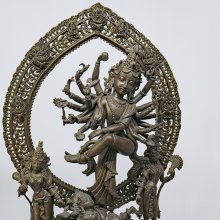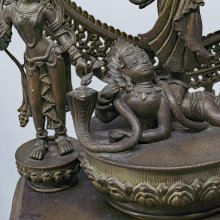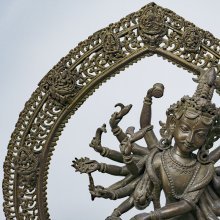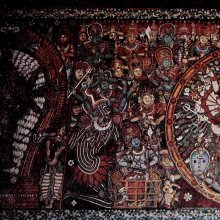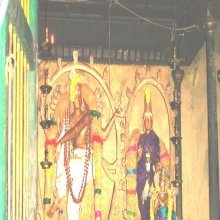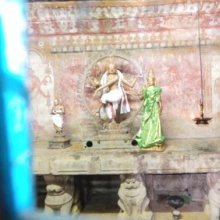Nataraja, Naṭarāja: 7 definitions
Introduction:
Nataraja means something in Hinduism, Sanskrit. If you want to know the exact meaning, history, etymology or English translation of this term then check out the descriptions on this page. Add your comment or reference to a book if you want to contribute to this summary article.
Images (photo gallery)
(+11 more images available)
In Hinduism
Shilpashastra (iconography)
Source: Red Zambala: Hindu Icons and Symbols | TrinityThe well-known bronze sculpture of Naṭarāja (the King of Dancer) is considered to be one of the most beautiful pieces of art produced by Indian craftsmen. Every Śiva temple has a shrine dedicated to Śiva in his form of Naṭarāja performing the Ānanda tāṇḍava — the “Dance of Bliss”. In this icon we are instructed in the five functions of the Supreme Being: creation, sustenance, transformation, revealing and concealing.
The Dance takes place within a ring of flames which symbolises the cycle of births and deaths, the cycle of universal creation and destruction — projection and withdrawal. The god dances upon the back of the “Dwarf of Ignorance” known as Mulayaka. It is ignorance of our true nature that binds us to cycle of continual becoming and it is wisdom/ enlightenment that release us.
Source: Archaeological Survey of India: Śaiva monuments at Paṭṭadakal (śilpa)Naṭarāja (नटराज) is a sculpture found at the temple of Lokeśvara.—The gallery of images on the south façade of Lokeśvara temple starts with Naṭarāja or dancing Śiva in talasaṃsphoṭita pose. In this picture of dancing Śiva, we see him trampling hard on the back of Apasmārapuruṣa with the left foot. The god holds ḍamaru and nandidhvaja in his upper right and left hands respectively. The other two are in varada and karihasta.
Naṭarāja (नटराज) is also found as a sculpture on the exterior (western wall) of the temple of Trailokyeśvara.—This is one of the most beautiful images of Naṭarāja with eight hands in the Trailokyeśvara. Here dancing Śiva is depicted standing with the left foot in kuñcita or agratala and the other in samapāda with a left hand in karihasta and the corresponding right probably in sarpaśīrṣa. The second lower right and the third left hands are in dola, whereas the third and fourth upper right hands are with attributes. The uppermost right holds probably a trident but it looks like a crescent moon. There is something in the next immediate lower but it is damaged. The uppermost left holds a thing which looks like the hood of a snake.
Source: Shodhganga: The significance of the mūla-beras (śilpa)1) Naṭarāja (नटराज) is the name of a deity depicted in the Thillai Nataraja Temple in Cidambaram (Chidambaram) which is one of the Pañcasabhā or “five halls where Śiva is said to have danced”.—The mūla-bera of the Tillai Naṭarāja Temple is Naṭarāja. The image of Naṭarāja is set in the proportion of the uttama-daśatāla. The naṭa-māna (reduction in height due to flexion) should be 10, 11 or 12 viral. The right leg of the lord is placed on the back of a demon called Muyalagan and the left leg is raised and in the upper right hand he holds a kettle-drum or uḍukkai in ḍamaru-hasta or siṃhamukha’s mouth opened. In the upper left hand he carries a fire pot (agni) in prālambha/ardhacandra-hasta. The lower right hand is held in the patāka-hasta while the lower left hand is bent across to the right side in the position of an elephant’s trunk, its fingers pointing below and towards the left leg which is raised in a dancing position. Pārvatī is seen holding a flower in the right hand in kapittha-hasta and the left hand in dolā-hasta.
In iconography dancing Naṭarāja is seen with four hands where the upper right hand holds ḍamaru-hasta (udukkai) and the upper left hand holds ardhacandra-hasta (agni). The lower right hand is in abhaya-hasta and the lower left hand is in gaja-hasta or the elephant trunk. The right leg is placed on the ground in kṣipta and the left leg is raised. Pārvatī is seen holding a flower in the right hand in kaṭaka/siṃhakarṇa-hasta and the left hand in dolā-hasta.
2) Naṭarāja is also depicted in the Meenakshi Temple in Madurai (or Madura), which represents a sacred place for the worship of The Goddess (Devī).—Next to Kalyāṇa Sundarar’s sannidhi is the hundred-pillared hall (meditation hall) where the dancing Naṭarāja is seen with Pārvatī. The dancing Naṭarāja is described thus: The right leg of the lord is placed on the back of a demon called Muyalaga and the left leg is raised and in the upper right hand he holds a kettle-drum or uḍukkai in ḍamaru-hasta or siṃhamukha’s mouth opened. In the upper left hand, he carries a fire pot (agni) in prālambha-hasta. The lower right hand is held in the patāka-hasta while the lower left hand is bent across to the right in the position of an elephant’s trunk, its fingers pointing below towards the left leg which is raised in a dancing position. Pārvatī is seen holding a flower in the right hand in kapittha-hasta and the left hand is in dolā-hasta.
When seen from the view of iconography, dancing Naṭarāja is seen with four hands where the upper right hand holds the ḍamaru-hasta (udukkai) and the upper left hand holds ardhacandra-hasta (agni). The lower right hand is in abhaya-hasta and the lower left hand is in gaja-hasta or the elephant trunk. The right leg is placed on the ground in kṣipta and the left leg is raised. Pārvatī is seen holding a flower in the right hand using the kaṭaka/siṃhakarṇa-hasta and the left hand is in dolā-hasta.

Shilpashastra (शिल्पशास्त्र, śilpaśāstra) represents the ancient Indian science (shastra) of creative arts (shilpa) such as sculpture, iconography and painting. Closely related to Vastushastra (architecture), they often share the same literature.
Natyashastra (theatrics and dramaturgy)
Source: Wisdom Library: Nāṭya-śāstraNaṭarāja (नटराज) refers to “great dancer-actor”. The term is used throughout nāṭyaśāstra literature.

Natyashastra (नाट्यशास्त्र, nāṭyaśāstra) refers to both the ancient Indian tradition (shastra) of performing arts, (natya—theatrics, drama, dance, music), as well as the name of a Sanskrit work dealing with these subjects. It also teaches the rules for composing Dramatic plays (nataka), construction and performance of Theater, and Poetic works (kavya).
Vastushastra (architecture)
Source: Shodhganga: Temples of Salem region Up to 1336 ADNaṭarāja (नटराज).—Naṭarāja is the dancing form of Śiva, also called by the name Tāṇḍava. There are different forms of dancing Śiva identified by different names. The most popular is the Naṭarāja. Other forms are Sandhyatāṇḍava, Ūrdhvatāṇḍava, Gajāntakatāṇḍava, etc. The sculptures of this deity as wall reliefs and also in the round on the shafts of pillars are noticed. Naṭarāja is a very important form of Śiva worshiped throughout Tamilnadu.

Vastushastra (वास्तुशास्त्र, vāstuśāstra) refers to the ancient Indian science (shastra) of architecture (vastu), dealing with topics such architecture, sculpture, town-building, fort building and various other constructions. Vastu also deals with the philosophy of the architectural relation with the cosmic universe.
Shaivism (Shaiva philosophy)
Source: Shodhganga: The significance of the mūla-beras (shaivism)Naṭarāja refers to one of the manifestations of Śiva.—Śiva is manifested in various forms [viz., Naṭarāja]. In these forms, the primary substance is Śiva, with various other forms and attributes. The manifestations of Śiva, with their respective characteristics, have their own peculiarity and individuality. Each divinity has a specific attribute of its own. Amongst all his manifestations, the form of Śiva–Naṭarāja is very special in appearance and it connotes high philosophical meanings.
It is believed that a prayer made by the devotee to Naṭarāja helps him/her to free from the cycle of births and deaths. It gives great hope to him/her for freedom from all sin and attainment of the highest bliss. Śiva dancing on the pedestal shaped like a lotus flower makes the devotees feel that the Lord is dancing in their hearts. The lotus shaped pedestal usually represents Muyalaga denoting the three impurities (āṇava, māya, kanma).

Shaiva (शैव, śaiva) or Shaivism (śaivism) represents a tradition of Hinduism worshiping Shiva as the supreme being. Closely related to Shaktism, Shaiva literature includes a range of scriptures, including Tantras, while the root of this tradition may be traced back to the ancient Vedas.
Languages of India and abroad
Kannada-English dictionary
Source: Alar: Kannada-English corpusNaṭarāja (ನಟರಾಜ):—[noun] Śiva, the presiding deity of dancing art.
Kannada is a Dravidian language (as opposed to the Indo-European language family) mainly spoken in the southwestern region of India.
See also (Relevant definitions)
Starts with: Natarajasana.
Full-text (+50): Vyaghrapada, Natarudra, Natarajasana, Tantavamurtti, Chidambaram, Tirucciṟṟampalam-kōyil, Patanjali, Akacacapai, Apasmarasuran, Thillai, Kuncitapatam, Capapati, Atalaracu, Tampiracapai, Svarna-Bhairava, Niruttacapai, Tiruccapai, Nellai Murugan, Gaja Hasta, Irattinacapai.
Relevant text
Search found 24 books and stories containing Nataraja, Nata-raja, Naṭa-rāja, Naṭarāja; (plurals include: Natarajas, rajas, rājas, Naṭarājas). You can also click to the full overview containing English textual excerpts. Below are direct links for the most relevant articles:
Sculpture at its Best < [May-June, 1929]
Gauri–A Southern Bronze < [September 1944]
Book Reviews < [July – September, 2008]
Garga Samhita (English) (by Danavir Goswami)
Verses 2.12.13-15 < [Chapter 12 - Subduing Kāliya and Drinking the Forest Fire]
Early Chola Temples (by S. R. Balasubrahmanyam)
Bronze, group 2: Age of Aditya I (a.d. 871-907) < [Chapter XI - Sculpture]
Temples in Konerirajapuram < [Chapter VIII - Temples of Uttama Chola’s Time]
Bronze, group 1: Late Pallava and Early Chola—Age of Vijayalaya (a.d. 785-871) < [Chapter XI - Sculpture]
Later Chola Temples (by S. R. Balasubrahmanyam)
Temples in Melaperumballam < [Chapter IV - Temples of Vikrama Chola’s Time]
Part I - Manavalap-perumal and Kopperunjinga < [Chapter XVII - Chola-Pallava Phase (The Later Pallavas)]
Temples in Chidambaram < [Chapter IV - Temples of Vikrama Chola’s Time]
Middle Chola Temples (by S. R. Balasubrahmanyam)
Temples in Tiruvorriyur < [Chapter IV - Temples of Rajendra I’s Time]
Temples in Tiruppudaimarudil < [Chapter II - Temples of Rajaraja I’s Time]
Sabhapati-mandapa < [Tanjavur/Thanjavur (Rajarajesvaram temple)]
Abhinaya-darpana (English) (by Ananda Coomaraswamy)
Related products
